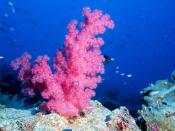Biological Species and Reproductive Isolation Species is a Latin word meaning áðkindáñ or áðappearanceáñ (Dictionary). Indeed, we learn to distinguish between the kinds of plants or animals from differences in their appearance. Linnaeus, the founder of modern taxonomy, described individual species in terms of their physical form (Campbell, 446). However, species is not considered just as a population of similarly looking organisms any more.
The most wildly accepted species definition, known as the biological species concept, was first enunciated by Ernst Mary, an evolutionary biologist (Biological Species Concept). The biological species concept defines a species as a population or group of populations whose members have the potential to interbreed with one another in nature to produce viable, fertile offspring, but who cannot produce viable, fertile offspring with members of other species (Campbell, 446). Members of a biological species are united by being reproductively compatible, at least potentially. For example, a male tax driver in New York has little probability of producing offspring with a female teacher in Mongolia, but if they should get together, they could produce offspring.
Thus, they belong to the same biological species. In fact, all humans belong to the same biological species. In contrast, humans and chimpanzees remain distinct biological species even where they share territory, because the two cannot interbreed. Then, what makes two species reproductively incompatible? Reproductive barriers can be divided into two categories: Prezygotic barriers and postzygotic barriers.
Prezygotic barriers impede mating between species or hinder the fertilization of ova, which are unfertilized eggs, if members of different species attempt to mate (Campbell, 447). Habitat isolation is a prezygotic barrier in which different habitual areas lead to reproductive incompatibility. For example, a snake in a species whose members live in water will not mate with another snake, which belongs to a different species whose members live on land.
Signals and elaborate behaviors are important methods to attract and recognize mates among animals. For example, male fireflies of various species signal to females of their kind by blinking their lights in particular patterns (Campbell, 447). The females respond only to signals characteristic of their own species, flashing back and attracting the males. Even a little difference in blinking patterns of two species acts as a reproductive barrier in this example. This kind of reproductive barrier resulted from different behaviors of two species is called behavioral isolation.
Two species that breed during different times of the day, different seasons, or different years cannot mix their gametes, which are sex cells. For example, the geographical ranges of the western spotted skunk and the eastern spotted skunk overlap, but these two very similar species do not interbreed because western spotted skunks mate in late summer and eastern spotted skunks mate in late winter (Campbell, 447). This reproductive barrier due to difference in reproductive period is called temporal isolation.
Closely related species may attempt to mate, but fail to consummate the act because of mechanic isolation, a reproductive isolation due to anatomical incompatibility. For example, mechanical barriers contribute to reproductive isolation of flowering plants that are pollinated by insects or other animals. Floral anatomy is often adapted to certain pollinators that transfer pollen only among plants of the same species.
Even if every previous prezygotic barrier has been overcome, two species cannot produce viable offspring if two gametes do not successfully meet to fertilize. For animals which perform internal fertilization, the sperm of one species may not be able to survive in the environment of the female reproductive tract of another species. Many aquatic animals release their gametes into water. Even if two closely related species release their gametes in the same place at the same time, gamete recognition based on specific molecules on surface of an egg cell which adhere only to complement molecules on sperm cells will prevent fertilization of two different species (Campbell, Ch 46). A similar mechanism of molecular recognition enables a flower to discriminate between pollen of the same species and pollen of different species (Campbell, Ch 38). This type of prezygotic barrier is called gametic isolation.
If a sperm cell from one species does fertilize an ovum of another species, then postzygotic barriers prevent the hybrid zygote from developing into a viable, fertile offspring. When prezygotic barriers are overcome and a hybrid zygote is formed, genetic incompatibility between two species may abort development of the hybrid at some embryonic stage. Even if two species mate and produce hybrid offspring that are vigorous, reproductive isolation is intact if the hybrids are completely or largely sterile. Also, even if the hybrid offspring are fertile, offspring of the next generation may be feeble or sterile, which acts as the final postzygotic barrier. For example, different cotton species can produce fertile hybrids, but breakdown occurs in the next generation when offspring of the hybrids die as seeds or grow into weak and defective plants (Campbell, 447).
When every prezygotic and postzygotic barrier is overcome, two groups of individuals can be referred to belong to the same biological species, which can produce fertile, viable offspring with its own members, not with members of another. Reading up to this point, you may have wondered the reason that Iáïve been using the word áðbiological speciesáñ rather than áðspeciesáñ. Even though the biological species concept is widely accepted and used to classify individuals into species, it does not work in all situations. For example, it is inadequate for grouping extinct forms of life or individuals which reproduce only asexually (Limitations). Because of infeasibility of the biological species concept in some situations like above, taxonomists have developed several other definitions of species, which will be briefly discussed next.
Morphological species concept categorizes individuals according to their physical features (Campbell, 448). This concept was used in almost all situations in early taxonomy systems, and today it is extensively used to group fossils, for which tests for possibility of interbreed between individuals are impossible. Another proposal for defining species, the ecological species concept, defines species on the basis of their habitats and niches, which are roles in a community (Campbell, 448). Yet another definition, the cohesion species concept, focuses on the mechanisms that maintain species as discrete phenotypic entities (Campbell, 449). Asexual reproduction is an effective cohesion mechanism, and in contrast to the biological species concept, the cohesion concept is applicable to organisms that reproduce without sex such as amoeba or fungi.
Biologically, members of two groups do not belong to a same species unless they have potential to produce viable, fertile offspring. Even if they have overcome many reproductive barriers that prevent fertilization of an egg cell by a sperm cell, not only the offspring but also the next generation should be viable and fertile for the two groups to be classified as one species. Even though the biological species concept works well in most situations, one should not consider it as the sole classification method, but should be flexible to choose a species concept that is adequate for a given situation.





